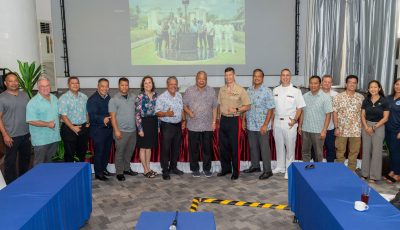Memorial Day
“And death shall have no dominion” is from the Welsh poet Dylan Thomas known to purveyors of English literature. To readers of the New Testament of the Bible, the theme comes from St. Paul’s letter to the Romans.
Memorial Day is now our secular commemoration of the truth that death, indeed, has no dominion. It is not because Paul says so, or that he says so in reference to Jesus. Nor hardly has its authenticity dependent on its being in a religious scripture. It is true because that’s the way life is, regardless of what tradition one stands on.
Memorial Day observed on the last Monday of May was formerly Decoration Day, commemorating all men and women who died in military service for the United States. It started with the recognition of Union soldiers who lost their lives during the American Civil War inspired by the way the southern states honored their dead. (Slaves on May 1, 1865, unearthed the mass grave of Union soldiers at a Confederate prisoner’s camp, and gave them proper burial.) It was extended to WWI uniformed casualties, and later, on anyone who died in any military action, war or no war.
Memorial Day comes at the end of spring and the onset of summer in the northern hemisphere. It is a good day to visit cemeteries, to prepare for incoming ice days, and gather the family if we could. In fact, the last half of May tends to be memorial days in the United States, at least in my calendar, starting with the Peace Officers’ Day in the middle of the month and extending through D-Day in June and patriotic Fourth of July. So, rather than a day to close-out autumn and prepare to hibernate in winter, I consider our choice of May more than just a memorial to military deaths as it is a celebration of the gift of life in its fullness.
China just completed its hosting of CICA (Conference on Interaction and Confidence Building Measures in Asia) in Shanghai, trying to move the sense of “security” out of the military mindset into the concern of citizens, particularly the internal capacities to stem separatism and extremism.
Born and bred in the Philippines before taking U.S. citizenship, and a part-time resident of Saipan and Honolulu, I am quite familiar with the intent of SEATO that was our NATO in Southeast Asia, and now, the ASEAN, which is our EU. Europe and Asia are not the same, nor are their organized efforts similar but they are both initiated and stoked by the military, political, and economic interests of the United States. Among cynical colleagues in Asia, ASEAN is a coffee break tête-à-tête at a U.S. coffee shop!
One of the provisions of the joint declaration that came out of Shanghai (attended by 46 countries with the U.S. as an observer) was the sense that a military alliance between an Asian country with a third party should not be at the expense of heightened insecurity of the Asian country’s neighbor. Historically, this can only be in reference to U.S. continued military meddling in the Koreas and the maritime disputes in the South China Sea, and the sale of Black Hawk “death from above” technologies to Brunei and Taiwan.
When China articulated its need for a National Security Commission early this month in light of the actions of rebels in an earlier attack at Tiananmen Square in Beijing, the machete/bolo attacks in Yunnan and elsewhere, the Uighur attacks in Xinjiang while China’s President Xi Jinping was on a visit, our U.S. State Department had the temerity to ask that China prove allegations that they were under internal attack.
This week, two bombs in two fancy SUVs were driven through a busy public market in Urmuqi, Xinjiang (Uighur country) as the CICA meeting in Shanghai was being held. There are in China internal security issues beyond the machete/bolo crowd that Western media continually portrays.
Let us ignore government policies for a moment. As a teacher in the Western tradition for the last 40 years, I am only aware of the type of thinking we imbue on our students when we ask them to “compare and contrast” things, and in our revered methodology of having participants identify the “underlying contradiction” in strategic planning. Nothing methodologically wrong with both, save the compare-and-contrast method often leads to the oneupmanship hierarchical structure of society where one is decreed to be better than another. Though identifying concrete contradictions help planning to rise from mere wishful thinking that deteriorates into the eternal Zoroastrian battle of good-and-evil, we are increasingly getting clear that only in dealing with concrete “rocks-in-the-middle-of-the-road” realities can planning actually move forward.
Memorial Day is not when we draw the line to leave some people out as it is to broaden a circle so that we can get everyone in. In the movie The Last Samurai, the Tom Cruise character was asked by the Emperor of the warrior who died with his sword swinging against the volleys of lead: “Tell me how he died.” Tom Cruise replied: “I’ll tell you how he lived.”
A colleague on Saipan is fond of saying, “It is not what I am willing to die for that is at issue; what I aim to live for,” is. Enjoy your lagoon BBQ!



























